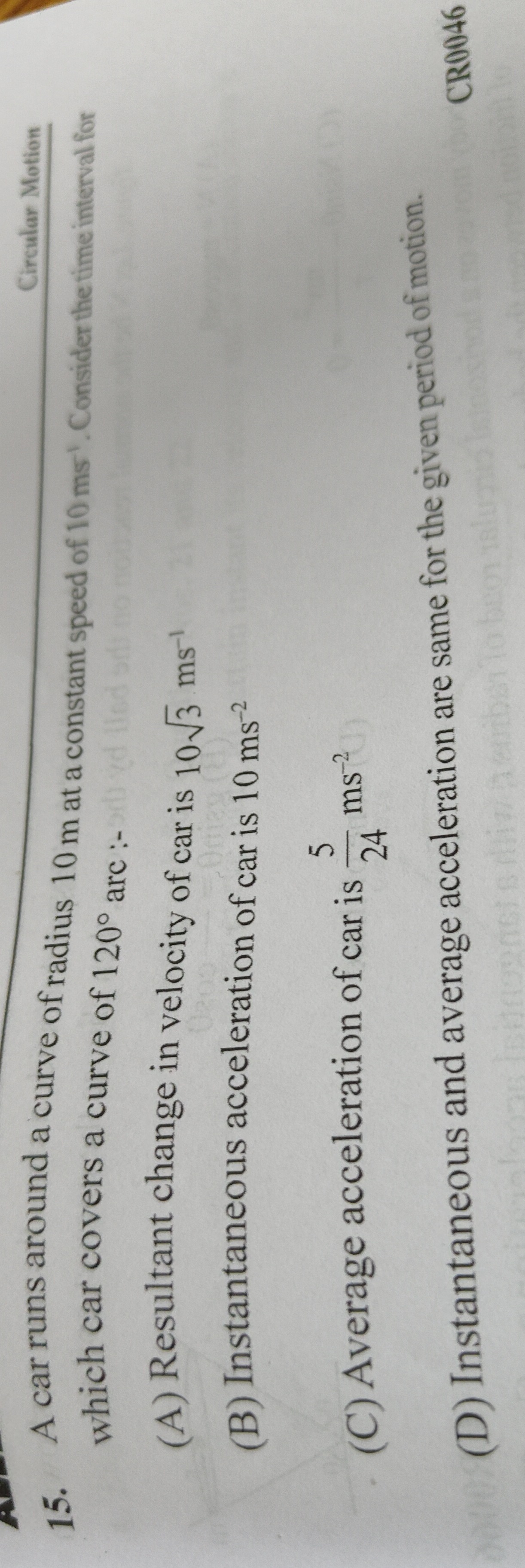Question
Question: A car runs around a curve of radius 10 m at a constant speed of 10 ms¹ Consider the time interval fo...
A car runs around a curve of radius 10 m at a constant speed of 10 ms¹ Consider the time interval for which car covers a curve of 120° arc:-

Resultant change in velocity of car is 10√3 ms¹
Instantaneous acceleration of car is 10 ms⁻²
Average acceleration of car is 245 ms⁻²
Instantaneous and average acceleration are same for the given period of motion.
A, B
Solution
The car is undergoing uniform circular motion.
Given:
- Radius of the curve, R=10 m
- Constant speed, v=10 m/s
- Arc covered, θ=120∘
Let's evaluate each option:
(A) Resultant change in velocity of car is 103 ms⁻¹
In uniform circular motion, the magnitude of the velocity remains constant, but its direction changes. The change in velocity is a vector difference. Let the initial velocity be v1 and the final velocity be v2. ∣v1∣=∣v2∣=v=10 m/s. The angle between the initial and final velocity vectors is equal to the angle of the arc covered, θ=120∘. The magnitude of the change in velocity, ∣Δv∣=∣v2−v1∣, can be calculated using the law of cosines or the formula for change in velocity in uniform circular motion: ∣Δv∣=2vsin(2θ) Substitute the given values: ∣Δv∣=2×10×sin(2120∘) ∣Δv∣=20×sin(60∘) ∣Δv∣=20×23 ∣Δv∣=103 m/s So, option (A) is correct.
(B) Instantaneous acceleration of car is 10 ms⁻²
In uniform circular motion, the instantaneous acceleration is the centripetal acceleration, which is directed towards the center of the circle. Its magnitude is given by: ac=Rv2 Substitute the given values: ac=10 m(10 m/s)2 ac=10 m100 m2/s2 ac=10 m/s² So, option (B) is correct.
(C) Average acceleration of car is 245 ms⁻²
Average acceleration is defined as the total change in velocity divided by the time interval: aavg=ΔtΔv We already found ∣Δv∣=103 m/s. Now, we need to calculate the time interval Δt. The arc length covered, s=Rθrad, where θrad is the angle in radians. θ=120∘=120×180π radians=32π radians. s=10 m×32π=320π m. Since the speed is constant, the time taken is: Δt=speedarc length=vs Δt=10 m/s20π/3 m=32π s. Now, calculate the magnitude of the average acceleration: ∣aavg∣=Δt∣Δv∣=2π/3 s103 m/s ∣aavg∣=2π103×3=2π303=π153 m/s². Numerically, π153≈3.1415915×1.732≈3.1415925.98≈8.27 m/s². The value given in option (C) is 245≈0.208 m/s². Clearly, our calculated value is not equal to 245 m/s². So, option (C) is incorrect.
(D) Instantaneous and average acceleration are same for the given period of motion. Instantaneous acceleration is 10 m/s² and its direction continuously changes (always pointing towards the center). Average acceleration has a magnitude of π153 m/s² and a fixed direction (the direction of Δv, which is constant for the entire interval). Since their magnitudes are different (10=π153) and their directions are generally different, they are not the same. So, option (D) is incorrect.
Final conclusion: Options (A) and (B) are correct.
Explanation of the solution:
- Change in Velocity (Option A): For uniform circular motion, the magnitude of velocity is constant, but its direction changes. The change in velocity vector is calculated using vector subtraction. The magnitude of the change in velocity for an angle θ is 2vsin(θ/2). Substituting v=10 m/s and θ=120∘, we get 103 m/s.
- Instantaneous Acceleration (Option B): In uniform circular motion, the instantaneous acceleration is the centripetal acceleration, given by ac=v2/R. Substituting v=10 m/s and R=10 m, we find ac=10 m/s².
- Average Acceleration (Option C): Average acceleration is the total change in velocity divided by the time taken. We calculated the magnitude of change in velocity as 103 m/s. The time taken to cover a 120∘ arc is Δt=arc length/speed. Arc length is Rθrad=10×(2π/3)=20π/3 m. So, Δt=(20π/3)/10=2π/3 s. The magnitude of average acceleration is (103)/(2π/3)=153/π m/s², which is not equal to 5/24 m/s².
- Comparison of Accelerations (Option D): Instantaneous acceleration continuously changes direction (towards the center), while average acceleration has a fixed direction for the given interval. Their magnitudes are also different. Hence, they are not the same.
